Adaptive Fiber Ring Laser Based on Tapered Polarization Maintaining Fiber in Sagnac Loop for Temperature and Salinity Sensing
Abstract
1. Introduction
2. Working Principle and Experimental Setup
3. Results
4. Discussion
5. Conclusions
Author Contributions
Funding
Institutional Review Board Statement
Informed Consent Statement
Data Availability Statement
Acknowledgments
Conflicts of Interest
References
- Wang, L.; Wang, Y.J.; Song, S.; Li, F. Overview of Fibre Optic Sensing Technology in the Field of Physical Ocean Observation. Front. Phys. 2021, 9, 558. [Google Scholar] [CrossRef]
- Qian, Y.; Zhao, Y.; Wu, Q.-L.; Yang, Y. Review of salinity measurement technology based on optical fiber sensor. Sens. Actuators B Chem. 2018, 260, 86–105. [Google Scholar] [CrossRef]
- Liang, H.; Wang, J.; Zhang, L.; Liu, J.; Wang, S. Review of Optical Fiber Sensors for Temperature, Salinity, and Pressure Sensing and Measurement in Seawater. Sensors 2022, 22, 5363. [Google Scholar] [CrossRef] [PubMed]
- Li, G.; Wang, Y.; Shi, A.; Liu, Y.; Li, F. Review of Seawater Fiber Optic Salinity Sensors Based on the Refractive Index Detection Principle. Sensors 2023, 23, 2187. [Google Scholar] [CrossRef]
- Zhao, Y.; Liao, Y. Novel optical fiber sensor for simultaneous measurement of temperature and salinity. Sens. Actuators B Chem. 2002, 86, 63–67. [Google Scholar] [CrossRef]
- Yang, H.; Wang, S.; Wang, X.; Wang, J.; Liao, Y. Temperature sensing in seawater based on microfiber knot resonator. Sensors 2014, 14, 18515–18525. [Google Scholar] [CrossRef]
- Wang, S.; Yang, H.; Liao, Y.; Wang, X.; Wang, J. High-Sensitivity Salinity and Temperature Sensing in Seawater Based on a Microfiber Directional Coupler. IEEE Photon.-J. 2016, 8, 1–9. [Google Scholar] [CrossRef]
- Nguyen, L.V.; Vasiliev, M.; Alameh, K. Three-Wave Fiber Fabry–Pérot Interferometer for Simultaneous Measurement of Temperature and Water Salinity of Seawater. IEEE Photon.-Technol. Lett. 2011, 23, 450–452. [Google Scholar] [CrossRef]
- Siyu, E.; Zhang, Y.-N.; Han, B.; Zheng, W.; Wu, Q.-L.; Zheng, H.-K. Two-Channel Surface Plasmon Resonance Sensor for Simultaneous Measurement of Seawater Salinity and Temperature. IEEE Trans. Instrum. Meas. 2020, 69, 7191–7199. [Google Scholar] [CrossRef]
- Sun, M.-Y.; Jiang, H.-T.; Shi, B.; Zhou, G.-Y.; Inyang, H.I.; Feng, C.-X. Development of FBG salinity sensor coated with lamellar polyimide and experimental study on salinity measurement of gravel aquifer. Measurement 2019, 140, 526–537. [Google Scholar] [CrossRef]
- Hou, Y.-F.; Wang, J.; Wang, X.; Liao, Y.-P.; Yang, L.; Cai, E.-L.; Wang, S.-S. Simultaneous Measurement of Pressure and Temperature in Seawater with PDMS Sealed Microfiber Mach-Zehnder Interferometer. J. Light. Technol. 2020, 38, 6412–6421. [Google Scholar] [CrossRef]
- Yu, Y.; Bian, Q.; Lu, Y.; Zhang, X.; Yang, J.; Liang, L. High Sensitivity All Optical Fiber Conductivity-Temperature-Depth (CTD) Sensing Based on an Optical Microfiber Coupler (OMC). J. Light. Technol. 2019, 37, 2739–2747. [Google Scholar] [CrossRef]
- Kilic, O.; Digonnet, M.J.F.; Kino, G.S.; Solgaard, O. Miniature photonic-crystal hydrophone optimized for ocean acoustics. J. Acoust. Soc. Am. 2011, 129, 1837–1850. [Google Scholar] [CrossRef]
- Wang, Y.; Tong, R.-J.; Zhao, K.-J.; Xing, B.; Li, X.; Hu, S.; Zhao, Y. Optical fiber sensor based on SPR and MZI for seawater salinity and temperature measurement. Opt. Laser Technol. 2023, 162, 109315. [Google Scholar] [CrossRef]
- Zhao, F.; Lin, W.; Hu, J.; Liu, S.; Yu, F.; Chen, X.; Wang, G.; Shum, P.P.; Shao, L.-Y. Highly sensitive salinity and temperature measurement based on tapered-SHF MZI fiber laser structure. Meas. Sci. Technol. 2023, 34, 064002. [Google Scholar] [CrossRef]
- An, G.; Liu, L.; Hu, P.; Jia, P.-G.; Zhu, F.; Zhang, Y.; Liu, J.; Xiong, J. Probe type TFBG-excited SPR fiber sensor for simultaneous measurement of multiple ocean parameters assisted by CFBG. Opt. Express 2023, 31, 4229. [Google Scholar] [CrossRef]
- Ji, L.; Zhao, S.; Sun, Q.; Yang, S.; Bai, X.; Zhao, P.; Su, J.; Wu, C. Seawater temperature measurement system based on wavelength sweeping and cross correlation algorithm. IEEE Sens. J. 2023, 23, 9280–9286. [Google Scholar] [CrossRef]
- Grilli, R.; Triest, J.; Chappellaz, J.; Calzas, M.; Desbois, T.; Jansson, P.; Guillerm, C.; Ferré, B.; Lechevallier, L.; Ledoux, V.; et al. Sub-Ocean: Subsea Dissolved Methane Measurements Using an Embedded Laser Spectrometer Technology. Environ. Sci. Technol. 2018, 52, 10543–10551. [Google Scholar] [CrossRef]
- Liao, Y.; Yang, K.; Shi, X. Theoretical study on simultaneous measurement of seawater temperature and salinity based on dual fiber interferometers combined with nonlinear decoupling algorithm. Measurement 2023, 211, 112596. [Google Scholar] [CrossRef]
- Santosh, R.; Lee, H.-S.; Ji, H.; Kim, Y.-D. Effect of thermal characteristics on the chemical quality of real-brine treatment through hydrophilic fiber-based low-grade heat-powered humidification-dehumidification process. Water Res. 2023, 233, 119771. [Google Scholar] [CrossRef]
- Pereira, D.A.; Frazão, O.; Santos, J.L. Fiber Bragg grating sensing system for simultaneous measurement of salinity and temperature. Opt. Eng. 2004, 43, 299–304. [Google Scholar] [CrossRef]
- Amiri, I.S.; Paul, B.K.; Ahmed, K.; Aly, A.H.; Zakaria, R.; Yupapin, P.; Vigneswaran, D. Tri-core photonic crystal fiber based refractive index dual sensor for salinity and temperature detection. Microw. Opt. Technol. Lett. 2019, 61, 847–852. [Google Scholar] [CrossRef]
- Xu, W.; Yang, X.; Zhang, C.; Shi, J.; Xu, D.; Zhong, K.; Yang, K.; Li, X.; Fu, W.; Liu, T.; et al. All-fiber seawater salinity sensor based on fiber laser intracavity loss modulation with low detection limit. Opt. Express 2019, 27, 1529–1537. [Google Scholar] [CrossRef]
- Lin, W.; Liu, Y.; Shum, P.P.; Shao, L. In-Line Mach Zehnder Interferometer Based on Ytterbium Doped Fiber with Up-Taper Structure in Fiber Ring Laser and Its Application in Sensing. Sensors 2022, 22, 9196. [Google Scholar] [CrossRef]
- Lin, W.; Zhou, S.; Shao, L.-Y.; Vai, M.I.; Shum, P.P.; Zhao, F.; Liu, S.; Hu, J.; Liu, Y. In-Fiber Mach–Zehnder Interferometer Based on Er Doped Up-Taper and Peanut-Shaped Fiber Structure in Fiber Ring Laser. IEEE Access 2021, 9, 128126–128132. [Google Scholar] [CrossRef]
- Cai, L.; Wang, M.; Zhao, Y. Investigation on refractive index sensing characteristics based on multimode fiber specklegram. Meas. Sci. Technol. 2022, 34, 015125. [Google Scholar] [CrossRef]
- Culshaw, B. The optical fibre Sagnac interferometer: An overview of its principles and applications. Meas. Sci. Technol. 2006, 17, R1–R16. [Google Scholar] [CrossRef]
- Kim, H.-M.; Kim, T.-H.; Kim, B.; Chung, Y. Temperature-Insensitive Torsion Sensor With Enhanced Sensitivity by Use of a Highly Birefringent Photonic Crystal Fiber. IEEE Photon.-Technol. Lett. 2010, 22, 1539–1541. [Google Scholar] [CrossRef]
- Frazão, O.; Silva, S.; Baptista, J.; Santos, J.L.; Statkiewicz-Barabach, G.; Urbanczyk, W.; Wojcik, J. Simultaneous measurement of multiparameters using a Sagnac interferometer with polarization maintaining side-hole fiber. Appl. Opt. 2008, 47, 4841–4848. [Google Scholar] [CrossRef]
- De La Rosa, E.; Zenteno, L.A.; Starodumov, A.N.; Monzon, D. All-fiber absolute temperature sensor using an unbalanced high-birefringence Sagnac loop. Opt. Lett. 1997, 22, 481–483. [Google Scholar] [CrossRef]
- Shao, L.-Y.; Luo, Y.; Zhang, Z.; Zou, X.; Luo, B.; Pan, W.; Yan, L. Sensitivity-enhanced temperature sensor with cascaded fiber optic Sagnac interferometers based on Vernier-effect. Opt. Commun. 2015, 336, 73–76. [Google Scholar] [CrossRef]
- Luo, H.; Sun, Q.; Li, Y.; Liu, D.; Zhang, L. Highly Birefringent D-Shaped Microfiber and Its Application in High-Sensitive Optical Sensing. IEEE Sens. J. 2016, 16, 4793–4797. [Google Scholar] [CrossRef]
- Reyes-Vera, E.; Cordeiro, C.M.B.; Torres, P. Highly sensitive temperature sensor using a Sagnac loop interferometer based on a side-hole photonic crystal fiber filled with metal. Appl. Opt. 2017, 56, 156–162. [Google Scholar] [CrossRef] [PubMed]
- Sun, L.-P.; Yuan, Z.; Huang, T.; Sun, Z.; Lin, W.; Huang, Y.; Xiao, P.; Yang, M.; Li, J.; Guan, B.-O. Ultrasensitive sensing in air based on Sagnac interferometer working at group birefringence turning point. Opt. Express 2019, 27, 29501–29509. [Google Scholar] [CrossRef] [PubMed]
- Madry, M.; Alwis, L.; Binetti, L.; Pajewski, L.; Beres-Pawlik, E. Simultaneous Measurement of Temperature and Relative Humidity Using a Dual-Wavelength Erbium-Doped Fiber Ring Laser Sensor. IEEE Sens. J. 2019, 19, 9215–9220. [Google Scholar] [CrossRef]
- Gong, M.; Yuan, Y.; Li, C.; Yan, P.; Zhang, H.; Liao, S. Numerical modeling of transverse mode competition in strongly pumped multimode fiber lasers and amplifiers. Opt. Express 2007, 15, 3236–3246. [Google Scholar] [CrossRef]
- Sun, C.; Dong, Y.; Wang, M.; Jian, S. Liquid level and temperature sensing by using dual-wavelength fiber laser based on multimode interferometer and FBG in parallel. Opt. Fiber Technol. 2018, 41, 212–216. [Google Scholar] [CrossRef]
- Bui, H.; Pham, T.B.; Nguyen, V.A.; Pham, V.D.; Do, T.C.; Nguyen, T.V.; Hoang, T.H.C.; Le, H.T. Novel method of dual fiber Bragg gratings integrated in fiber ring laser for biochemical sensors. Meas. Sci. Technol. 2018, 29, 055105. [Google Scholar] [CrossRef]
- Zhong, X.; Hu, J.; Curty, M.; Qian, L.; Lo, H.K. Proof-of-Principle Experimental Demonstration of Twin-Field Type Quantum Key Distribution. Phys. Rev. Lett. 2019, 123, 100506. [Google Scholar] [CrossRef]
- Zhou, M.G.; Cao, X.Y.; Lu, Y.S.; Wang, Y.; Bao, Y.; Jia, Z.Y.; Fu, Y.; Yin, H.L.; Chen, Z.B. Experimental Quantum Advantage with Quantum Coupon Collector. Research 2022, 2022, 9798679. [Google Scholar] [CrossRef]
- Park, C.H.; Woo, M.K.; Park, B.K.; Kim, Y.-S.; Baek, H.; Lee, S.-W.; Lim, H.-T.; Jeon, S.-W.; Jung, H.; Kim, S.; et al. 2×N twin-field quantum key distribution network configuration based on polarization, wavelength, and time division multiplexing. npj Quantum Inf. 2022, 8, 48. [Google Scholar] [CrossRef]
- Gu, J.; Cao, X.Y.; Fu, Y.; He, Z.W.; Yin, Z.J.; Yin, H.L.; Chen, Z.B. Experimental measurement-device-independent type quantum key distribution with flawed and correlated sources. Sci. Bull. 2022, 67, 2167–2175. [Google Scholar] [CrossRef] [PubMed]
- Zhang, Y.; Wu, Y.; Han, Y.; Mao, Y.; Wu, J.; Zhao, L.; Tang, R.; Ren, J.; Liu, B. Simultaneous temperature and refractive index sensor based on an L-like Michelson interferometer. Appl. Opt. 2021, 60, 10101–10108. [Google Scholar] [CrossRef] [PubMed]
- Shao, M.; Han, L.; Sun, H.; Yin, X.; Qiao, X. A liquid refractive index sensor based on 3-core fiber Michelson interferometer. Opt. Commun. 2019, 453, 124356. [Google Scholar] [CrossRef]
- Tian, J.; Lu, Z.; Quan, M.; Jiao, Y.; Yao, Y. Fast response Fabry–Perot interferometer microfluidic refractive index fiber sensor based on concave-core photonic crystal fiber. Opt. Express 2016, 24, 20132–20142. [Google Scholar] [CrossRef]
- Tian, M.; Lu, P.; Chen, L.; Liu, D.; Yang, M. Micro Multicavity Fabry–Pérot Interferometers Sensor in SMFs Machined by Femtosecond Laser. IEEE Photonics Technol. Lett. 2013, 25, 1609–1612. [Google Scholar] [CrossRef]
- Li, L.; Xia, L.; Xie, Z.; Liu, D. All-fiber Mach-Zehnder interferometers for sensing applications. Opt. Express 2012, 20, 11109–11120. [Google Scholar] [CrossRef]
- Wang, J.; Zhou, J.; Hao, J.; Zeng, X.; Chen, W.; Liu, Y.; Meng, H.; Sun, J.; Geng, T.; Sun, W. Simultaneous Measurement of Dual Parameters Based on Periodically Embedding MMF-Induced Ultralong-Period Fiber Grating. IEEE Sens. J. 2023, 23, 1191–1196. [Google Scholar] [CrossRef]

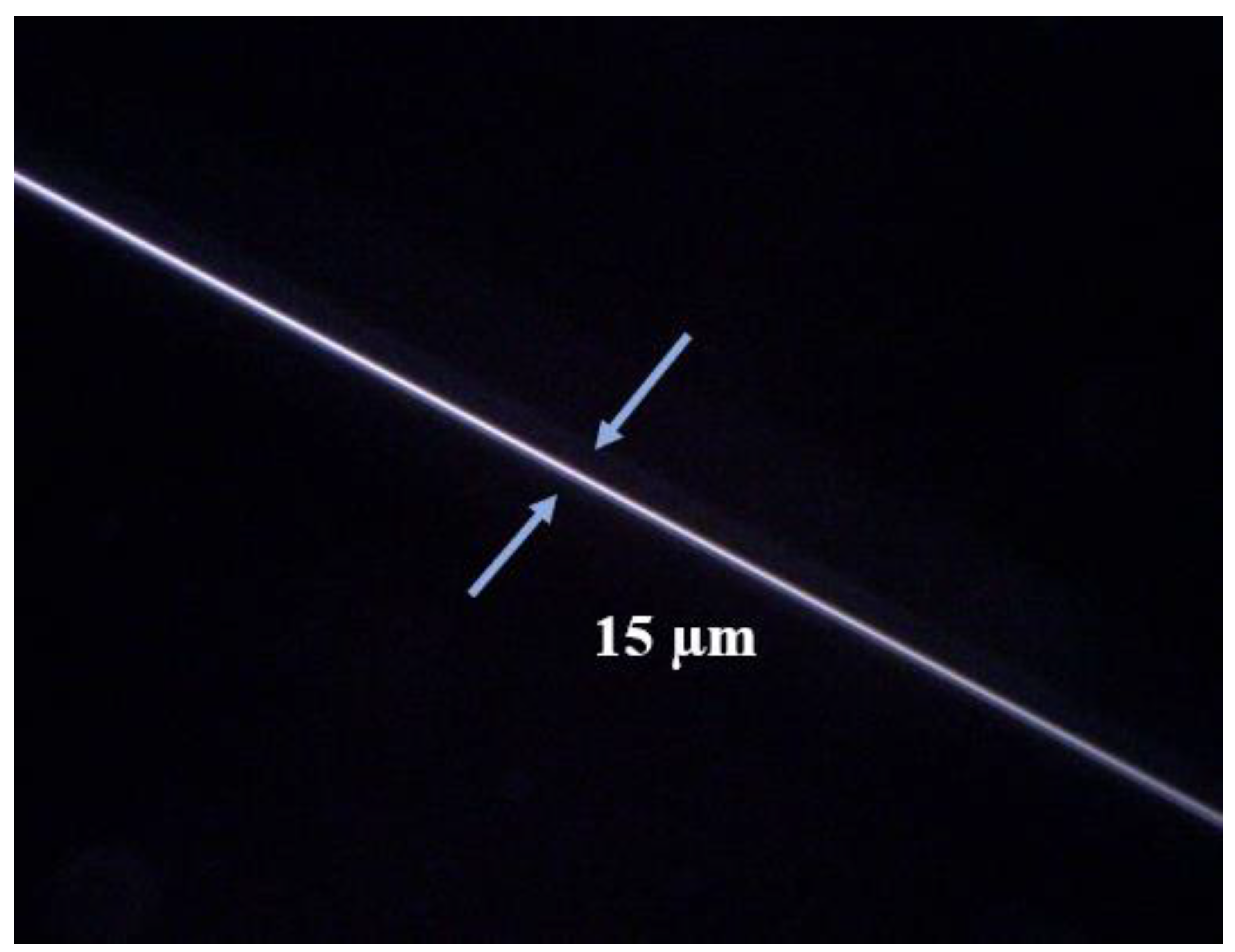


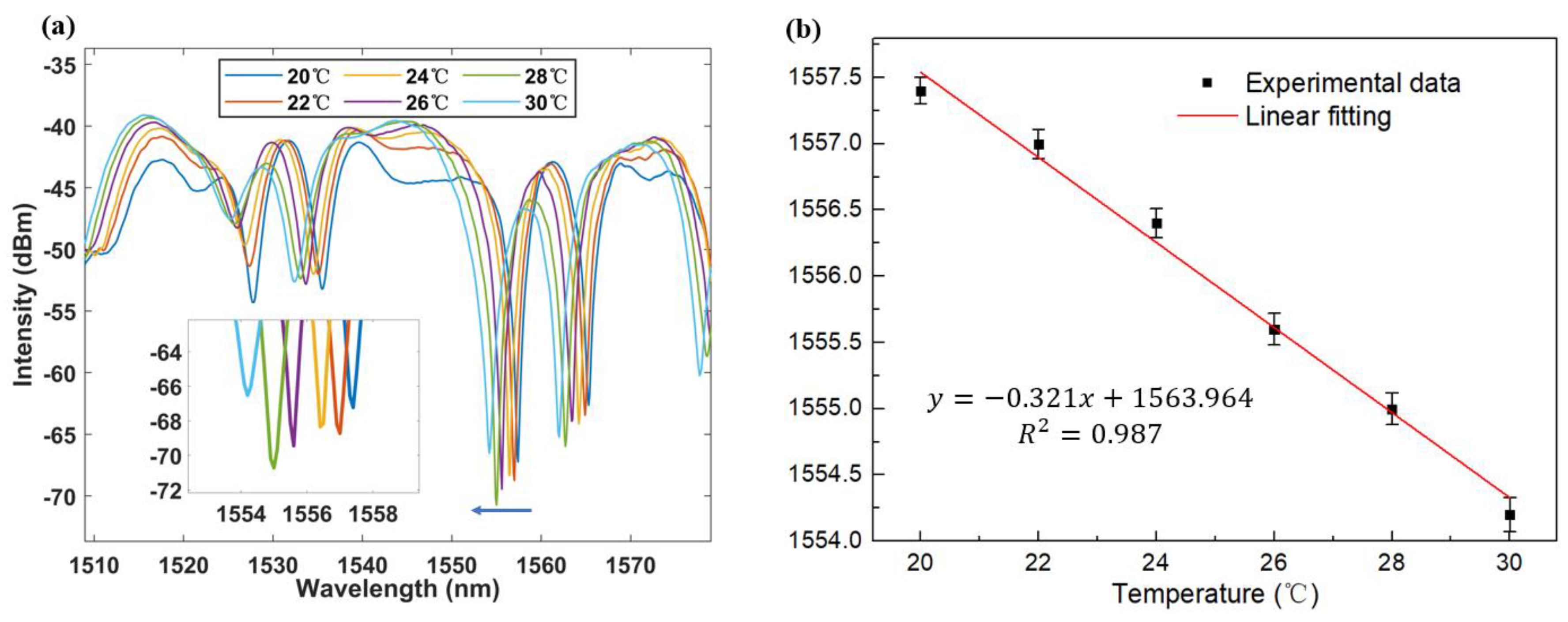
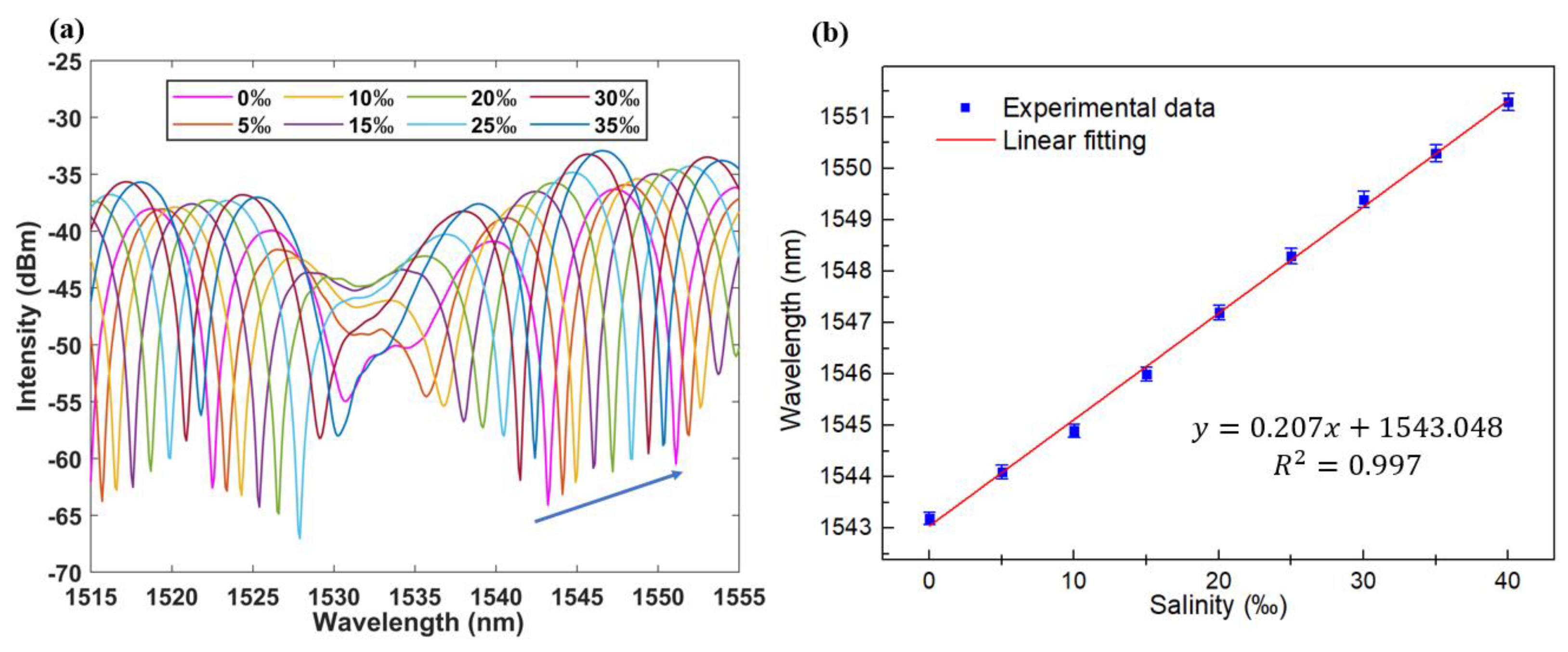


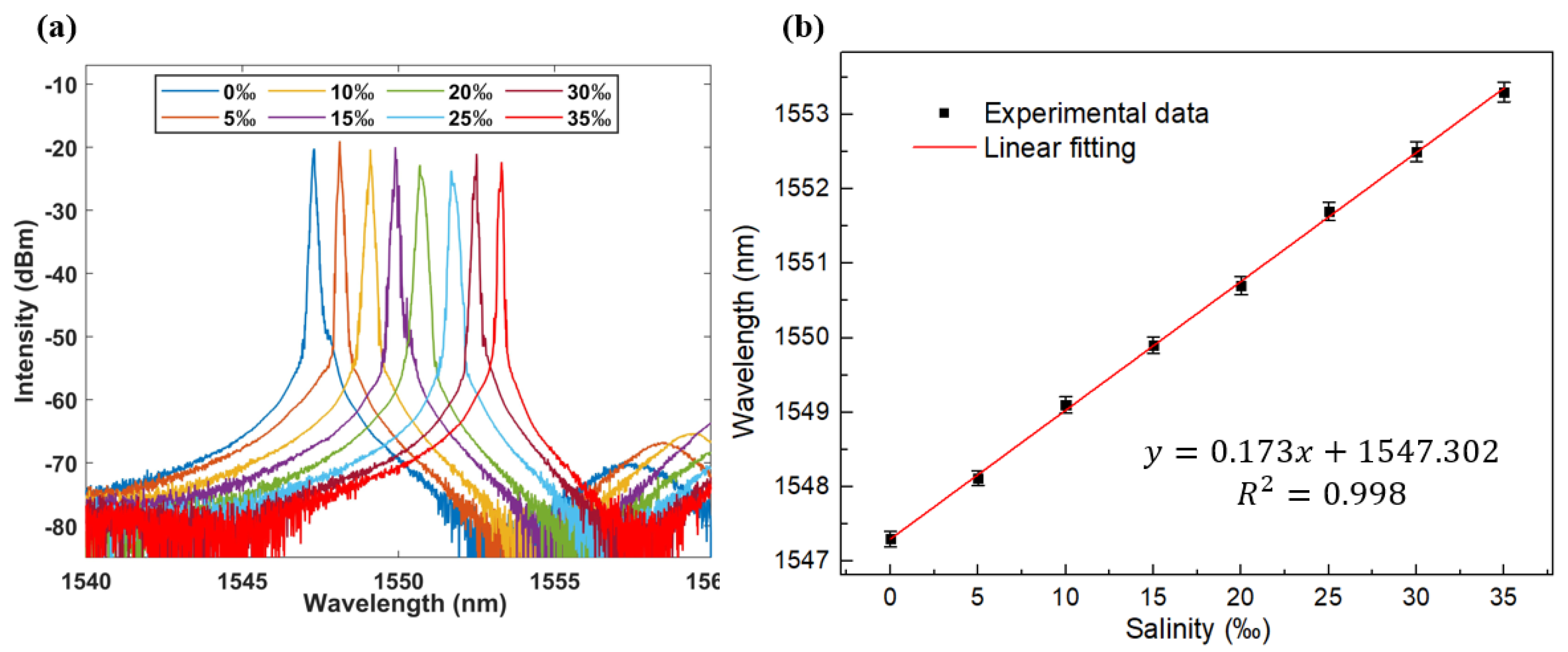


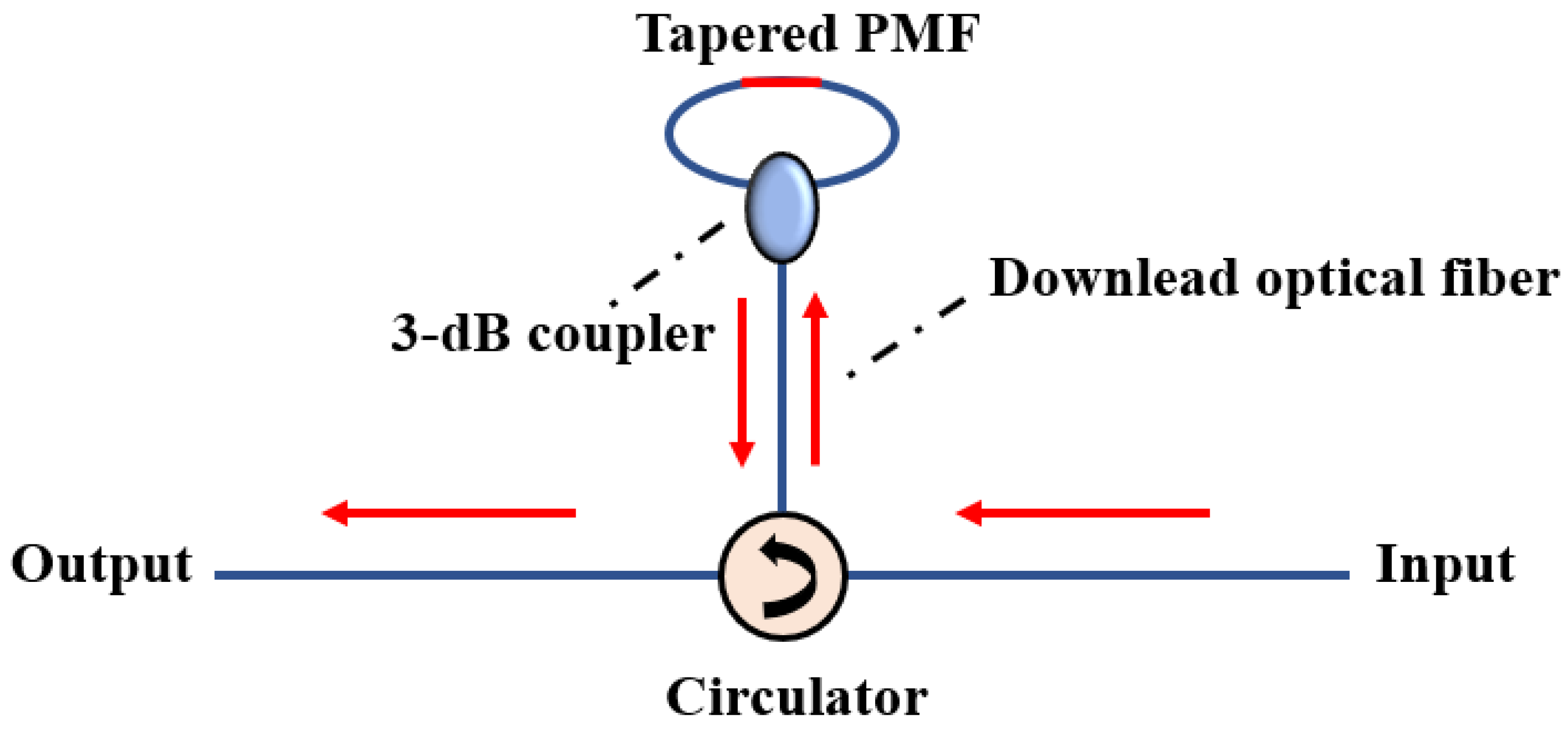
| Structures | Temperature Sensitivity (nm/°C) | Refractive Index Sensitivity (nm/RIU) | Ref. |
|---|---|---|---|
| L-like MI | 0.094 | 53.05 | [43] |
| 3-core fiber MI | 0.048 | \ | [44] |
| Concave PCF FPI | 0.002 | 1635.62 | [45] |
| Multicavity FPI | 0.011 | 1074.36 | [46] |
| SMTS MZI | 0.0615 | 25.2935 | [47] |
| MMF-LPFG | 0.092 | 1230 | [48] |
| This work | 0.306 | 980.622 |
Disclaimer/Publisher’s Note: The statements, opinions and data contained in all publications are solely those of the individual author(s) and contributor(s) and not of MDPI and/or the editor(s). MDPI and/or the editor(s) disclaim responsibility for any injury to people or property resulting from any ideas, methods, instructions or products referred to in the content. |
© 2023 by the authors. Licensee MDPI, Basel, Switzerland. This article is an open access article distributed under the terms and conditions of the Creative Commons Attribution (CC BY) license (https://creativecommons.org/licenses/by/4.0/).
Share and Cite
Liu, Y.; Lin, W.; Zhao, F.; Hu, J.; Chen, J.; Liu, H.; Shum, P.P.; Zhang, X.; Shao, L.-Y. Adaptive Fiber Ring Laser Based on Tapered Polarization Maintaining Fiber in Sagnac Loop for Temperature and Salinity Sensing. Photonics 2023, 10, 599. https://doi.org/10.3390/photonics10050599
Liu Y, Lin W, Zhao F, Hu J, Chen J, Liu H, Shum PP, Zhang X, Shao L-Y. Adaptive Fiber Ring Laser Based on Tapered Polarization Maintaining Fiber in Sagnac Loop for Temperature and Salinity Sensing. Photonics. 2023; 10(5):599. https://doi.org/10.3390/photonics10050599
Chicago/Turabian StyleLiu, Yuhui, Weihao Lin, Fang Zhao, Jie Hu, Jinna Chen, Huanhuan Liu, Perry Ping Shum, Xuming Zhang, and Li-Yang Shao. 2023. "Adaptive Fiber Ring Laser Based on Tapered Polarization Maintaining Fiber in Sagnac Loop for Temperature and Salinity Sensing" Photonics 10, no. 5: 599. https://doi.org/10.3390/photonics10050599
APA StyleLiu, Y., Lin, W., Zhao, F., Hu, J., Chen, J., Liu, H., Shum, P. P., Zhang, X., & Shao, L.-Y. (2023). Adaptive Fiber Ring Laser Based on Tapered Polarization Maintaining Fiber in Sagnac Loop for Temperature and Salinity Sensing. Photonics, 10(5), 599. https://doi.org/10.3390/photonics10050599







